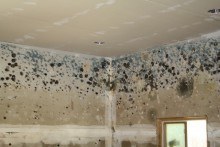Mold Remediation

Issues concerning mold growth have dramatically increased in homes and businesses. Owners have become increasingly aware and better educated about the perils of excessive mold exposure. A variety of adverse health effects and symptoms, including allergic reactions may be caused by exposure to mold. Many homeowners and business owners are concerned about potential mold growth and its negative health effects on family, friends, tenants, employees and customers. The best solution is to seek a consultation with trained mold detection and Florida Licensed Mold Assessors, like the professionals at Alpha Environmental Diagnostics, LLC. Mold assessment is best performed by professionals who have the experience and training to determine if mold levels are too high in your indoor environment. Beyond detecting mold levels, Alpha Environmental’s professionals can help detect the source and find a solution to remove the mold and stop it from returning.
Mold removal is a not an easy task. Simply spraying with bleach and water may not remove the toxigenic effects of mold. Many times cleaning of mold by the homeowner is possible; other times, mold remediation may require removal of the mold damaged materials carefully and correctly by professionals to eliminate the spread of the spores so that other rooms or locations around the problematic areas are not exposed. These pesky airborne spores can easily be carried elsewhere in the indoor environment. Moldy materials should be contained and removed from the structure. Homeowners and business managers can underestimate the severity of mold in their structures and the degree of difficulty in removing the mold.
Mold grows readily on most organic substances when coupled with the presence of ample moisture and can be found in almost every household and business environment. Mold can also grow on paper, wood, carpet, foods and many building materials; mold amplification occurs when an excessive amount of moisture is present in buildings and on the surface of building materials. Problems are compounded when the actual source of the problem moisture stays hidden or uncorrected.
To reproduce, mold emits billions of tiny spores, similar in this case to dandelion seeds in the wind. Airborne mold spores can travel significant distances and are found both indoors/ outdoors. When mold spores land in a suitable wet environment, they quickly grow and overtake their host. Unchecked, such mold growth can eventually destroy the surfaces on which they grow.
Mold growth is known to cause a variety of health problems.
According to the Environmental Protection Agency (EPA):
Molds are usually not a problem indoors, unless mold spores land on a wet or damp spot and begin growing. Molds have the potential to cause health problems. Molds produce allergens (substances that can cause allergic reactions), irritants, and in some cases, potentially toxic substances (mycotoxins). Inhaling or touching mold or mold spores may cause allergic reactions in sensitive individuals. Allergic responses include hay fever-type symptoms, such as sneezing, runny nose, red eyes, and skin rash (dermatitis). Allergic reactions to mold are common. They can be immediate or delayed. Molds can also cause asthma attacks in people with asthma who are allergic to mold. In addition, mold exposure can irritate the eyes, skin, nose, throat, and lungs of both mold-allergic and non-allergic people.
http://www.epa.gov/mold/moldbasics.html
More specifically, The Centers for Disease Control and Prevention (CDC) advises other adverse human health reactions to mold exposure can include:
* Nasal stuffiness
* Eye irritation
* Wheezing
* Skin irritation
* Fever
* Shortness of breath
Some people with chronic lung illnesses, such as obstructive lung disease, may develop mold infections in their lungs.
In 2004 the Institute of Medicine (IOM) found there was sufficient evidence to link indoor exposure to mold with upper respiratory tract symptoms, cough, and wheeze in otherwise healthy people; with asthma symptoms in people with asthma; and with hypersensitivity pneumonitis in individuals susceptible to that immune-mediated condition. The IOM also found limited or suggestive evidence linking indoor mold exposure and respiratory illness in otherwise healthy children.
http://www.cdc.gov/mold/faqs.htm#affect
Controlling moisture in an environment is critical to mold control. Some of the more common areas for indoor mold growth are basements, bathrooms and near sinks and toilets. Moisture sources that can aid mold growth include leaking roofs or basements, plumbing problems, heavy rains and malfunctioning air conditioning units.
Alpha Environmental Diagnostics, LLC employs expert mold and indoor air quality professionals skilled in the process of mold detection, which includes addressing the source of mold growth and unwanted moisture accumulation. Thorough and complete mold detection and removal, again, is best performed by skilled and trained professionals.
